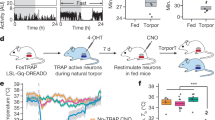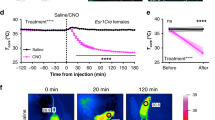Abstract
Mus musculus enters a torpid state in response to caloric restriction in sub-thermoneutral ambient temperatures. This torpid state is characterized by an adaptive and controlled decrease in metabolic rate, heart rate, body temperature, and activity. Previous research has identified the paraventricular nucleus (PVN) within the hypothalamus, a region containing oxytocin neurons, as a location that is active during torpor onset. We hypothesized that oxytocin neurons within the PVN are part of this neural circuit and that activation of oxytocin neurons would deepen and lengthen torpor bouts. We report that activation of oxytocin neurons alone is not sufficient to induce a torpor-like state in the fed mouse, with no significant difference in body temperature or heart rate upon activation of oxytocin neurons. However, we found that activation of oxytocin neurons prior to the onset of daily torpor both deepens and lengthens the subsequent bout, with a 1.7 ± 0.4 °C lower body temperature and a 135 ± 32 min increase in length. We therefore conclude that oxytocin neurons are involved in the neural circuitry controlling daily torpor in the mouse.





Similar content being viewed by others
References
Ambler M, Hitrec T, Pickering A (2021) Turn it off and on again: characteristics and control of torpor. Wellcome Open Res 6:313. https://doi.org/10.12688/wellcomeopenres.17379.2
Ambler M, Hitrec T, Wilson A, Cerri M, Pickering A (2022) Neurons in the dorsomedial hypothalamus promote, prolong, and deepen torpor in the mouse. J Neurosci 42(21):4267–4277. https://doi.org/10.1523/JNEUROSCI.2102-21.2022
Bouret SG, Draper SJ, Simerly RB (2004) Formation of projection pathways from the arcuate nucleus of the hypothalamus to hypothalamic regions implicated in the neural control of feeding behavior in mice. J Neurosci 24(11):2797–2805. https://doi.org/10.1523/JNEUROSCI.5369-03.2004
Braulke LJ, Heldmaier G (2010) Torpor and ultradian rhythms require an intact signalling of the sympathetic nervous system. Cryobiology 60(2):198–203. https://doi.org/10.1016/j.cryobiol.2009.11.001
Dergacheva O, Yamanaka A, Schwartz AR, Polotsky VY, Mendelowitz D (2016) Direct projections from hypothalamic orexin neurons to brainstem cardiac vagal neurons. Neuroscience 339:47–53. https://doi.org/10.1016/j.neuroscience.2016.09.038
Dergacheva O, Yamanaka A, Schwartz AR, Polotsky VY, Mendelowitz D (2017) Optogenetic identification of hypothalamic orexin neuron projections to paraventricular spinally projecting neurons. Am J Physiol Heart Circ Physiol 312(4):H808–H817. https://doi.org/10.1152/ajpheart.00572.2016
Dos-Santos RC, Grover HM, Reis LC, Ferguson AV, Mecawi AS (2018) Electrophysiological effects of Ghrelin in the hypothalamic paraventricular nucleus neurons. Front Cell Neurosci 12:275. https://doi.org/10.3389/fncel.2018.00275
Ferguson AV, Latchford KJ, Samson WK (2008) The paraventricular nucleus of the hypothalamus—a potential target for integrative treatment of autonomic dysfunction. Expert Opin Ther Targets 12(6):717–727. https://doi.org/10.1517/14728222.12.6.717
Garrott K, Dyavanapalli J, Cauley E, Dwyer MK, Kuzmiak-Glancy S, Wang X, Mendelowitz D, Kay MW (2017) Chronic activation of hypothalamic oxytocin neurons improves cardiac function during left ventricular hypertrophy-induced heart failure. Cardiovasc Res 113(11):1318–1328. https://doi.org/10.1093/cvr/cvx084
Geiser F, Ruf T (1995) Hibernation versus daily torpor in mammals and birds: physiological variables and classification of torpor patterns. Physiol Zool 68(6):935–966
Geiser F, Currie SE, O’Shea KA, Hiebert SM (2014) Torpor and hypothermia: reversed hysteresis of metabolic rate and body temperature. Am J Physiol Regul Integr Comp Physiol 307(11):R1324-1329. https://doi.org/10.1152/ajpregu.00214.2014
Guzman-Ruiz MA, Ramirez-Corona A, Guerrero-Vargas NN, Sabath E, Ramirez-Plascencia OD, Fuentes-Romero R, Leon-Mercado LA, Basualdo Sigales M, Escobar C, Buijs RM (2015) Role of the suprachiasmatic and arcuate nuclei in diurnal temperature regulation in the rat. J Neurosci 35(46):15419–15429. https://doi.org/10.1523/JNEUROSCI.1449-15.2015
Hitrec T, Luppi M, Bastianini S, Squarcio F, Berteotti C, Lo Martire V, Martelli D, Occhinegro A, Tupone D, Zoccoli G, Amici R, Cerri M (2019) Neural control of fasting-induced torpor in mice. Sci Rep 9(1):15462. https://doi.org/10.1038/s41598-019-51841-2
Hrvatin S, Sun S, Wilcox OF, Yao H, Lavin-Peter AJ, Cicconet M, Assad EG, Palmer ME, Aronson S, Banks AS, Griffith EC, Greenberg ME (2020) Neurons that regulate mouse torpor. Nature 583(7814):115–121. https://doi.org/10.1038/s41586-020-2387-5
Hudson JW, Scott IM (1979) Daily torpor in the laboratory mouse, Mus musculus Var. Albino. Physiol Zool 52(2):205–218
Jameson H, Bateman R, Byrne P, Dyavanapalli J, Wang X, Jain V, Mendelowitz D (2016) Oxytocin neuron activation prevents hypertension that occurs with chronic intermittent hypoxia/hypercapnia in rats. Am J Physiol Heart Circ Physiol 310(11):H1549-1557. https://doi.org/10.1152/ajpheart.00808.2015
Jurek B, Neumann ID (2018) The oxytocin receptor: from intracellular signaling to behavior. Physiol Rev 98(3):1805–1908. https://doi.org/10.1152/physrev.00031.2017
Madden CJ, Morrison SF (2009) Neurons in the paraventricular nucleus of the hypothalamus inhibit sympathetic outflow to brown adipose tissue. Am J Physiol Regul Integr Comp Physiol 296(3):R831-843. https://doi.org/10.1152/ajpregu.91007.2008
Melvin RG, Andrews MT (2009) Torpor induction in mammals: recent discoveries fueling new ideas. Trends Endocrinol Metab 20(10):490–498. https://doi.org/10.1016/j.tem.2009.09.005
Milsom WK, Zimmer MB, Harris MB (2001) Vagal control of cardiorespiratory function in hibernation. Exp Physiol 86(6):791–796. https://doi.org/10.1111/j.1469-445x.2001.tb00046.x
Ming Sheng Zhou HS (2014) Cardiovascular action of oxytocin. J Autacoids. https://doi.org/10.4172/2161-0479.1000e124
Morhardt JE (1970) Heart rates, breathing rates and the effects of atropine and acetylcholine on white-footed mice (Peromyscus sp.) during daily torpor. Comp Biochem Physiol 33(2):441–457. https://doi.org/10.1016/0010-406x(70)90360-9
Nakamura KM, Shaun F (2008) A thermosensory pathway that controls body temperature. Nat Neurosci 11(1):62–71
Norman RF (1995) Paraventricular nucleus ablation disrupts daily torpor in Siberian hamsters. Brain Res Bull 37(2):193–198
Ruf T, Geiser F (2015) Daily torpor and hibernation in birds and mammals. Biol Rev Camb Philos Soc 90(3):891–926. https://doi.org/10.1111/brv.12137
Swoap SJ, Gutilla MJ (2009) Cardiovascular changes during daily torpor in the laboratory mouse. Am J Physiol Regul Integr Comp Physiol 297(3):R769-774. https://doi.org/10.1152/ajpregu.00131.2009
Swoap SJ, Weinshenker D (2008) Norepinephrine controls both torpor initiation and emergence via distinct mechanisms in the mouse. PLoS One 3(12):e4038. https://doi.org/10.1371/journal.pone.0004038
Swoap SJ, Gutilla MJ, Liles LC, Smith RO, Weinshenker D (2006) The full expression of fasting-induced torpor requires beta 3-adrenergic receptor signaling. J Neurosci 26(1):241–245. https://doi.org/10.1523/JNEUROSCI.3721-05.2006
Takahashi TM, Sunagawa GA, Soya S, Abe M, Sakurai K, Ishikawa K, Yanagisawa M, Hama H, Hasegawa E, Miyawaki A, Sakimura K, Takahashi M, Sakurai T (2020) A discrete neuronal circuit induces a hibernation-like state in rodents. Nature 583(7814):109–114. https://doi.org/10.1038/s41586-020-2163-6
Takahashi TM, Hirano A, Kanda T, Saito VM, Ashitomi H, Tanaka KZ, Yokoshiki Y, Masuda K, Yanagisawa M, Vogt KE, Tokuda T, Sakurai T (2022) Optogenetic induction of hibernation-like state with modified human Opsin4 in mice. Cell Rep Methods 2(11):100336. https://doi.org/10.1016/j.crmeth.2022.100336
Tan CL, Cooke EK, Leib DE, Lin YC, Daly GE, Zimmerman CA, Knight ZA (2016) Warm-sensitive neurons that control body temperature. Cell 167(1):47–59. https://doi.org/10.1016/j.cell.2016.08.028. (e15)
van der Vinne V, Bingaman MJ, Weaver DR, Swoap SJ (2018) Clocks and meals keep mice from being cool. J Exp Biol. https://doi.org/10.1242/jeb.179812
Vicent MA, Borre ED, Swoap SJ (2017) Central activation of the A1 adenosine receptor in fed mice recapitulates only some of the attributes of daily torpor. J Comp Physiol B 187(5–6):835–845. https://doi.org/10.1007/s00360-017-1084-7
Wu YE, Enoki R, Oda Y, Huang ZL, Honma KI, Honma S (2018) Ultradian calcium rhythms in the paraventricular nucleus and subparaventricular zone in the hypothalamus. Proc Natl Acad Sci USA 115(40):E9469–E9478. https://doi.org/10.1073/pnas.1804300115
Yang Y, Yuan J, Field RL, Ye D, Hu Z, Xu K, Xu L, Gong Y, Yue Y, Kravitz AV, Bruchas MR, Cui J, Brestoff JR, Chen H (2023) Induction of a torpor-like hypothermic and hypometabolic state in rodents by ultrasound. Nat Metab 5(5):789–803. https://doi.org/10.1038/s42255-023-00804-z
Zhang Z, Reis F, He Y, Park JW, DiVittorio JR, Sivakumar N, van Veen JE, Maesta-Pereira S, Shum M, Nichols I, Massa MG, Anderson S, Paul K, Liesa M, Ajijola OA, Xu Y, Adhikari A, Correa SM (2020) Estrogen-sensitive medial preoptic area neurons coordinate torpor in mice. Nat Commun 11(1):6378. https://doi.org/10.1038/s41467-020-20050-1
Zhao Z-DY, Wen Z, Gao C, Fu X, Zhang W, Zhoud Q, Chen W, Ni X, Lin J-K, Yang J, Xu X-H, Shen WL (2017) A hypothalamic circuit that controls body temperature. Proc Natl Acad Sci USA 114(9):E1755. https://doi.org/10.1073/pnas.1701881114
Acknowledgements
The authors thank the animal care staff for their assistance. Funds were provided by Williams College to SJS and MC.
Author information
Authors and Affiliations
Corresponding author
Ethics declarations
Conflict of interest
The authors have no competing interests to declare that are relevant to the context of this article.
Additional information
Communicated by G.Heldmaier.
Publisher's Note
Springer Nature remains neutral with regard to jurisdictional claims in published maps and institutional affiliations.
Supplementary Information
Below is the link to the electronic supplementary material.
Rights and permissions
Springer Nature or its licensor (e.g. a society or other partner) holds exclusive rights to this article under a publishing agreement with the author(s) or other rightsholder(s); author self-archiving of the accepted manuscript version of this article is solely governed by the terms of such publishing agreement and applicable law.
About this article
Cite this article
Hare, M.T., Carter, M.E. & Swoap, S.J. Activation of oxytocinergic neurons enhances torpor in mice. J Comp Physiol B 194, 95–104 (2024). https://doi.org/10.1007/s00360-023-01528-y
Received:
Revised:
Accepted:
Published:
Issue Date:
DOI: https://doi.org/10.1007/s00360-023-01528-y




